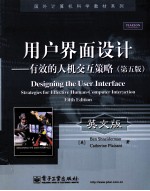

用户界面设计 有效的人机交互策略 第5版·英文版PDF电子书下载
- 电子书积分:18 积分如何计算积分?
- 作 者:(美)施奈德曼,(美)普莱萨特著
- 出 版 社:北京:电子工业出版社
- 出版年份:2010
- ISBN:9787121119125
- 页数:606 页
PART 1 INTRODUCTION 1
CHAPTER 1 Usability of Interactive Systems 3
CHAPTER 2 Guidelines,Principles,andTheories 55
PART 2 DEVELOPMENT PROCESSES 95
CHAPTER 3 Managing Design Processes 97
CHAPTER 4 Evaluating Interface Designs 131
PART 3 INTERACTION STYLES 171
CHAPTER 5 Direct Manipulation andVirtual Environments 173
CHAPTER 6 Menu Selection,Form Fill-in,and Dialog Boxes 225
CHAPTER 7 Command and Natural Languages 271
CHAPTER 8 Interaction Devices 303
CHAPTER 9 Collaboration and Social Media Participation 359
PART 4 DESIGN ISSUES 403
CHAPTER 10 Quality of Service 405
CHAPTER 11 Balancing Function and Fashion 433
CHAPTER 12 User Documentation and Online Help 477
CHAPTER 13 Information Search 513
CHAPTER 14 Information Visualization 537
Afterword Societal and Individual Impact of User Interfaces 563
Name index 581
Subject index 591
Acknowledgments 603
About the Authors 606
PART 1 INTRODUCTION 1
CHAPTER 1 Usability of Interactive Systems 3
1.1 Introduction 4
1.2 Usability Goals and Measures 13
1.3 Usability Motivations 15
1.4 Universal Usability 22
1.5 Goals for Our Profession 37
CHAPTER 2 Guidelines,Principles,and Theories 55
2.1 Introduction 56
2.2 Guidelines 57
2.3 Principles 62
2.4 Theories 79
PART 2 DEVELOPMENT PROCESSES 95
CHAPTER 3 Managing Design Processes 97
3.1 Introduction 98
3.2 Organizational Design to Support Usability 99
3.3 The Four Pillars of Design 102
3.4 Development Methodologies 108
3.5 Ethnographic Observation 111
3.6 Participatory Design 114
3.7 Scenario Development 116
3.8 Social Impact Statement for Early Design Review 119
3.9 Legal Issues 122
CHAPTER 4 Evaluating Interface Designs 131
4.1 Introduction 132
4.2 Expert Reviews 134
4.3 Usability Testing and Laboratories 138
4.4 Survey Instruments 149
4.5 AcceptanceTests 154
4.6 Evaluation During Active Use 156
4.7 Controlled Psychologically Oriented Experiments 162
PART 3 INTERACTION STYLES 171
CHAPTER 5 Direct Manipulation and Virtual Environments 173
5.1 Introduction 174
5.2 Examples of Direct Manipulation 175
5.3 Discussion of Direct Manipulation 193
5.4 3D Interfaces 200
5.5 Teleoperation 205
5.6 Virtual and Augmented Reality 209
CHAPTER 6 Menu Selection,Form Fill-in,and Dialog Boxes 225
6.1 Introduction 226
6.2 Task-Related Menu Organization 227
6.3 Single Menus 228
6.4 Combinations of Multiple Menus 236
6.5 Content Organization 244
6.6 Fast Movement through Menus 250
6.7 Data Entry with Menus:Form Fill-in,Dialog Boxes,and Alternatives 251
6.8 Audio Menus and Menus for Small Displays 259
CHAPTER 7 Command and Natural Languages 271
7.1 Introduction 272
7.2 Command-Organization Functionality,Strategies,and Structure 276
7.3 Naming and Abbreviations 281
7.4 Natural Language in Computing 286
CHAPTER 8 Interaction Devices 303
8.1 Introduction 304
8.2 Keyboards and Keypads 305
8.3 Pointing Devices 311
8.4 Speech and Auditory Interfaces 331
8.5 Displays-Small and Large 341
CHAPTER 9 Collaboration and Social Media Participation 359
9.1 Introduction 360
9.2 Goals of Collaboration and Participation 363
9.3 Asynchronous Distributed Interfaces:Different Place,Different Time 368
9.4 Synchronous Distributed Interfaces:Different Place,Same Time 383
9.5 Face-to-Face Interfaces:Same Place,Same Time 389
PART 4 DESIGN ISSUES 403
CHAPTER 10 Quality of Service 405
10.1 Introduction 406
10.2 Models of Response-Time Impacts 407
10.3 Expectations and Attitudes 416
10.4 User Productivity 420
10.5 Variability in Response Time 422
10.6 Frustrating Experiences 423
CHAPTER 11 Balancing Function and Fashion 433
11.1 Introduction 434
11.2 Error Messages 435
11.3 Nonanthropomorphic Design 440
11.4 Display Design 445
11.5 Web Page Design 451
11.6 Window Design 456
11.7 Color 465
CHAPTER 12 User Documentation and Online Help 477
12.1 Introduction 478
12.2 Online Versus Paper Documentation 480
12.3 Reading from Paper Versus from Displays 483
12.4 Shaping the Content of the Documentation 486
12.5 Accessing the Documentation 491
12.6 Online Tutorials and Animated Demonstrations 499
12.7 Online Communities for User Assistance 504
12.8 The Development Process 506
CHAPTER 13 Information Search 513
13.1 Introduction 514
13.2 Searching in Textual Documents and Database Querying 517
13.3 Multimedia Document Searches 525
13.4 Advanced Filtering and Search Interfaces 527
CHAPTER 14 Information Visualization 537
14.1 Introduction 538
14.2 DataType by Task Taxonomy 539
14.3 Challenges for Information Visualization 554
Afterword Societal and Individual Impact of User Interfaces 563
A.1 Future Interfaces 564
A.2 Ten Plagues of the Information Age 569
A.3 Continuing Controversies 573
Name index 581
Subject index 591
Acknowledgments 603
About the Authors 606
- 《卓有成效的管理者 中英文双语版》(美)彼得·德鲁克许是祥译;那国毅审校 2019
- 《一本书读懂无人机》姜魁著 2019
- 《Power BI数据清洗与可视化交互式分析》陈剑 2020
- 《战略情报 情报人员、管理者和用户手册》(澳)唐·麦克道尔(Don McDowell)著 2019
- 《AutoCAD 2018自学视频教程 标准版 中文版》CAD/CAM/CAE技术联盟 2019
- 《跟孩子一起看图学英文》张紫颖著 2019
- 《AutoCAD机械设计实例精解 2019中文版》北京兆迪科技有限公司编著 2019
- 《复分析 英文版》(中国)李娜,马立新 2019
- 《张世祥小提琴启蒙教程 中英文双语版》张世祥编著 2017
- 《UI界面设计的方法与应用实践研究》(中国)熊璐 2019
- 《电子测量与仪器》人力资源和社会保障部教材办公室组织编写 2009
- 《少儿电子琴入门教程 双色图解版》灌木文化 2019
- 《指向核心素养 北京十一学校名师教学设计 英语 七年级 上 配人教版》周志英总主编 2019
- 《北京生态环境保护》《北京环境保护丛书》编委会编著 2018
- 《指向核心素养 北京十一学校名师教学设计 英语 九年级 上 配人教版》周志英总主编 2019
- 《通信电子电路原理及仿真设计》叶建芳 2019
- 《高等院校旅游专业系列教材 旅游企业岗位培训系列教材 新编北京导游英语》杨昆,鄢莉,谭明华 2019
- 《电子应用技术项目教程 第3版》王彰云 2019
- 《中国十大出版家》王震,贺越明著 1991
- 《近代民营出版机构的英语函授教育 以“商务、中华、开明”函授学校为个案 1915年-1946年版》丁伟 2017
